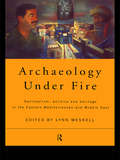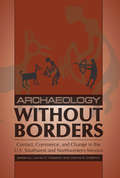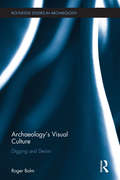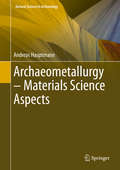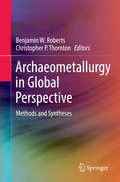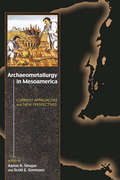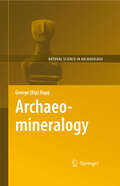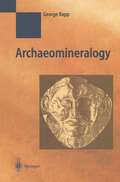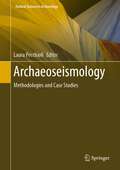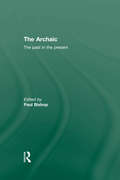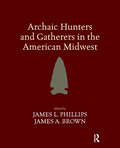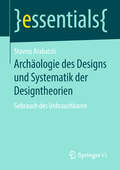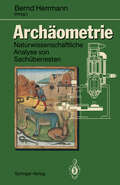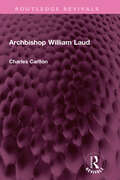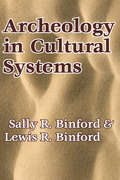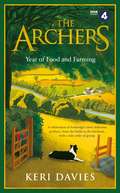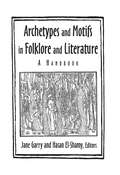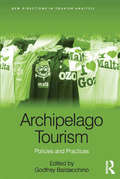- Table View
- List View
Archaeology Under Fire: Nationalism, Politics and Heritage in the Eastern Mediterranean and Middle East
by Lynn MeskellFirst published in 1998. Routledge is an imprint of Taylor & Francis, an informa company.
Archaeology Under Fire: Nationalism, Politics and Heritage in the Eastern Mediterranean and Middle East
by Lynn MeskellFirst published in 1998. Routledge is an imprint of Taylor & Francis, an informa company.
Archaeology without Borders: Contact, Commerce, and Change in the U.S. Southwest and Northwestern Mexico (Proceedings of SW Symposium)
by Eduardo Gamboa Carrera Maxine E. McBrinn Laurie D. WebsterArchaeology without Borders presents new research by leading U.S. and Mexican scholars and explores the impacts on archaeology of the border between the United States and Mexico. Including data previously not readily available to English-speaking readers, the twenty-four essays discuss early agricultural adaptations in the region and groundbreaking archaeological research on social identity and cultural landscapes, as well as economic and social interactions within the area now encompassed by northern Mexico and the U.S. Southwest. Contributors examining early agriculture offer models for understanding the transition to agriculture, explore relationships between the spread of agriculture and Uto-Aztecan migrations, and present data from Arizona, New Mexico, and Chihuahua. Contributors focusing on social identity discuss migration, enculturation, social boundaries, and ethnic identities. They draw on case studies that include diverse artifact classes - rock art, lithics, architecture, murals, ceramics, cordage, sandals, baskets, faunal remains, and oral histories. Mexican scholars present data from Chihuahua, Durango, Zacatecas, Michoacan, Coahuila, and Nuevo Leon. They address topics including Spanish-indigenous conflicts, archaeological history, cultural landscapes, and interactions among Mesoamerica, northern Mexico, and the U.S. Southwest. Laurie D. Webster is a visiting scholar in the Department of Anthropology at the University of Arizona. Maxine E. McBrinn is a postdoctoral research scientist at the Field Museum in Chicago. Proceedings of the 2004 Southwest Symposium. Contributors include Karen R. Adams, M. Nicolás Caretta, Patricia Carot, John Carpenter, Jeffery Clark, Linda S. Cordell, William E. Doolittle, Suzanne L. Eckert, Gayle J. Fritz, Eduardo Gamboa Carrera, Leticia González Arratia, Arturo Guevara Sánchez, Robert J. Hard, Kelly Hays-Gilpin, Marie-Areti Hers, Amber L. Johnson, Steven A. LeBlanc, Patrick Lyons, Jonathan B. Mabry, A. C. MacWilliams, Federico Mancera, Maxine E. McBrinn, Francisco Mendiola Galván, William L. Merrill, Martha Monzón Flores, Scott G. Ortman, John R. Roney, Guadalupe Sanchez de Carpenter, Moisés Valadez Moreno, Bradley J. Vierra, Laurie D. Webster, and Phil C. Weigand.
Archaeology's Visual Culture: Digging and Desire (Routledge Studies in Archaeology)
by Roger BalmArchaeology’s Visual Culture explores archaeology through the lens of visual culture theory. The insistent visuality of archaeology is a key stimulus for the imaginative and creative interpretation of our encounters with the past. Balm investigates the nature of this projection of the visual, revealing an embedded subjectivity in the imagery of archaeology and acknowledging the multiplicity of meanings that cohere around artifacts, archaeological sites and museum displays. Using a wide range of case studies, the book highlights how archaeologists can view objects and the consequences that ensue from these ways of seeing. Throughout the book Balm considers the potential for documentary images and visual material held in archives to perform cultural work within and between groups of specialists. With primary sources ranging from the mid-nineteenth to the early twenty-first century, this volume also maps the intellectual and social connections between archaeologists and their peers. Geographical settings include Britain, Cyprus, Mesoamerica, the Middle East and the United States, and the sites of visual encounter are no less diverse, ranging from excavation reports in salvage archaeology to instrumentally derived data-sets and remote-sensing imagery. By forensically examining selected visual records from published accounts and archival sources, enduring tropes of representation become apparent that transcend issues of style and reflect fundamental visual sensibilities within the discipline of archaeology.
Archaeology's Visual Culture: Digging and Desire (Routledge Studies in Archaeology)
by Roger BalmArchaeology’s Visual Culture explores archaeology through the lens of visual culture theory. The insistent visuality of archaeology is a key stimulus for the imaginative and creative interpretation of our encounters with the past. Balm investigates the nature of this projection of the visual, revealing an embedded subjectivity in the imagery of archaeology and acknowledging the multiplicity of meanings that cohere around artifacts, archaeological sites and museum displays. Using a wide range of case studies, the book highlights how archaeologists can view objects and the consequences that ensue from these ways of seeing. Throughout the book Balm considers the potential for documentary images and visual material held in archives to perform cultural work within and between groups of specialists. With primary sources ranging from the mid-nineteenth to the early twenty-first century, this volume also maps the intellectual and social connections between archaeologists and their peers. Geographical settings include Britain, Cyprus, Mesoamerica, the Middle East and the United States, and the sites of visual encounter are no less diverse, ranging from excavation reports in salvage archaeology to instrumentally derived data-sets and remote-sensing imagery. By forensically examining selected visual records from published accounts and archival sources, enduring tropes of representation become apparent that transcend issues of style and reflect fundamental visual sensibilities within the discipline of archaeology.
Archaeometallurgy – Materials Science Aspects (Natural Science in Archaeology)
by Andreas HauptmannThis book successfully connects archaeology and archaeometallurgy with geoscience and metallurgy. It addresses topics concerning ore deposits, archaeological field evidence of early metal production, and basic chemical-physical principles, as well as experimental ethnographic works on a low handicraft base and artisanal metal production to help readers better understand what happened in antiquity. The book is chiefly intended for scholars and students engaged in interdisciplinary work.
Archaeometallurgy in Global Perspective: Methods and Syntheses
by Benjamin W. Roberts Christopher P. ThorntonThe study of ancient metals in their social and cultural contexts has been a topic of considerable interest in archaeology and ancient history for decades, partly due to the modern dependence on technology and man-made materials. The formal study of Archaeometallurgy began in the 1970s-1980s, and has seen a recent growth in techniques, data, and theoretical movements. This comprehensive sourcebook on Archaeometallurgy provides an overview of earlier research as well as a review of modern techniques, written in an approachable way. Covering an extensive range of archaeological time-periods and regions, this volume will be a valuable resource for those studying archaeology worldwide. It provides a clear, straightforward look at the available methodologies, including:• Smelting processes• Slag analysis• Technical Ceramics• Archaeology of Mining and Field Survey• Ethnoarchaeology• Chemical Analysis and Provenance Studies• Conservation Studies With chapters focused on most geographic regions of Archaeometallurgical inquiry, researchers will find practical applications for metallurgical techniques in any area of their study. Ben Roberts is a specialist in the early metallurgy and later prehistoric archaeology of Europe. He was the Curator of the European Copper and Bronze Age collections at the British Museum between 2007 and 2012 and is now a Lecturer in Prehistoric Europe in the Department of Archaeology at the Durham University, UK. Chris Thornton is a specialist in the ancient metallurgy of the Middle East, combining anthropological theory with archaeometrical analysis to understand the development and diffusion of metallurgical technologies throughout Eurasia. He is currently a Consulting Scholar of the University of Pennsylvania Museum, where he received his PhD in 2009, and the Lead Program Officer of research grants at the National Geographic Society.
Archaeometallurgy in Mesoamerica: Current Approaches and New Perspectives
by Aaron N. Shugar Scott E. SimmonsPresenting the latest in archaeometallurgical research in a Mesoamerican context, Archaeometallurgy in Mesoamerica brings together up-to-date research from the most notable scholars in the field. These contributors analyze data from a variety of sites, examining current approaches to the study of archaeometallurgy in the region as well as new perspectives on the significance metallurgy and metal objects had in the lives of its ancient peoples. The chapters are organized following the cyclical nature of metals--beginning with extracting and mining ore, moving to smelting and casting of finished objects, and ending with recycling and deterioration back to the original state once the object is no longer in use. Data obtained from archaeological investigations, ethnohistoric sources, ethnographic studies, along with materials science analyses, are brought to bear on questions related to the integration of metallurgy into local and regional economies, the sacred connotations of copper objects, metallurgy as specialized crafting, and the nature of mining, alloy technology, and metal fabrication.
Archaeomineralogy (Natural Science in Archaeology)
by George Rapp“Archaeomineralogy” provides a wealth of information for mineralogists, geologists and archaeologists involved in archaeometric studies. The first edition was very well-received and praised for its systematic description of the rocks and minerals used throughout the world by our ancestors and for its excellent list of over 900 references, providing easy access to the fields of archaeomineralogy and geoarchaeology.This second edition of “Archaeomineralogy” takes an updated and expanded look at the human use of rocks and minerals from the Paleolithic through to the 18th century CE. It retains the structure and main themes of the original but has been revised and expanded with more than 200 new references within the text, a bibliography of additional references not included in the text, a dozen new figures (drawings and photos), coverage of many additional important mineral, rock, and gem materials, a broader geographic scope, particularly but not limited to Eastern Europe, and a more thorough review of early contributions to archaeomineralogy, especially those of Agricola. From reviews of the first edition:"… crammed full of useful information, is well-balanced using both new and Old World examples of the archaeomaterials described. It also provides a broad, but of necessity, all too brief overview of the geological raw materials used in antiquity." -- Geoscientist "…provides much interesting discussion of how particular names came to be employed by archaeologists working in different regions of the world…. much to offer for any geologist or archaeologist interested in minerals and rocks and how they have been used in the past." -- Mineralium Deposita"… a gem of a book, it's strength is that it is encyclopedic in content, if not in layout, draws on a wealth of field experience and almost every sentence contains a nugget of information" -- The Holocene
Archaeomineralogy (Natural Science in Archaeology)
by George R. Rapp1.1 Prologue What is archaeomineralogy? The term has been used at least once before (Mitchell 1985), but this volume is the first publication to lay down the scientific basis and systematics for this subdiscipline. Students sometimes call an introductory archaeology course "stones and bones." Archaeomineralogy covers the stones component of this phrase. Of course, archaeology consists of a great deal more than just stones and bones. Contemporary archaeology is based on stratigraphy, geomorphology, chronometry, behavioral inferences, and a host of additional disciplines in addition to those devoted to stones and bones. To hazard a definition: archaeomineralogy is the study of the minerals and rocks used by ancient societies over space and time, as implements, orna ments, building materials, and raw materials for ceramics and other processed products. Archaeomineralogy also attempts to date, source, or otherwise char acterize an artifact or feature, or to interpret past depositional alteration of archaeological contexts. Unlike geoarchaeology, archaeomineralogy is not, and is not likely to become, a recognized subdiscipline. Practitioners of archaeomineralogy are mostly geoarchaeologists who specialize in geology and have a strong background in mineralogy or petrology (the study of the origin ofrocks).
Archaeoseismology: Methodologies and Case Studies (Natural Science in Archaeology)
by Laura PecchioliArchaeoseismic research provides data and information on past earthquakes but is limited by the lack of ongoing discussions about methodology. This volume is an interdisciplinary approach including archaeologists, geologists, geophysicists, seismologists, engineers, and architects from different countries to present a comprehensive recording and interpretation of ancient natural disasters on some case studies. The publication is an introduction to various aspects of the field of archaeoseismology for the knowledge of past seismicity, the reconstruction of the chronological history of a place, the interpretation and identification of seismic effects using different methods, etc. The collection provides an overview of research into archaeoseismology, making new contributions through innovative ideas on various topics. The publication can be an illustrative introduction to better understand the complexity of interpreting seismic effects on ancient and modern masonries, particularly for students with an open mind.
The Archaic: The Past in the Present
by Paul BishopThe Archaic takes as its major reference points C.G. Jung's classic essay, 'Archaic Man' (1930), and Ernesto Grassi's paper on 'Archaic Theories of History' (1990). Moving beyond the confines of a Jungian framework to include other methodological approaches, this book explores the concept of the archaic. Defined as meaning 'old-fashioned', 'primitive', 'antiquated', the archaic is, in fact, much more than something very, very old: it is timeless, inasmuch as it is before time itself. Archē, Urgrund, Ungrund, 'primordial darkness', 'eternal nothing' are names for something essentially nameless, yet whose presence we nevertheless intuit. This book focuses on the reception of myth in the tradition of German Idealism or Romanticism (Creuzer, Schelling, Nietzsche), which not only looked back to earlier thinkers (such as Jacob Boehme) but also laid down roots for developments in twentieth-century thought (Ludwig Klages, Martin Heidegger). The Archaic also includes: studies of the Germanic dimension of the archaic (Charles Bambach, Alan Cardew) a discussion of the mytho-phenomenological approach to the archaic (Robert Josef Kozljanič) a series of articles on Jung's understanding of the archaic (Paul Bishop, Susan Rowland, Robert Segal). This book will be of interest to psychoanalysts, anthropologists and phenomenologists, as well as students of psychology, cultural studies, religious studies, and philosophy, as it seeks to rehabilitate a concept of demonstrable and urgent relevance for our time.
The Archaic: The Past in the Present
by Paul BishopThe Archaic takes as its major reference points C.G. Jung's classic essay, 'Archaic Man' (1930), and Ernesto Grassi's paper on 'Archaic Theories of History' (1990). Moving beyond the confines of a Jungian framework to include other methodological approaches, this book explores the concept of the archaic. Defined as meaning 'old-fashioned', 'primitive', 'antiquated', the archaic is, in fact, much more than something very, very old: it is timeless, inasmuch as it is before time itself. Archē, Urgrund, Ungrund, 'primordial darkness', 'eternal nothing' are names for something essentially nameless, yet whose presence we nevertheless intuit. This book focuses on the reception of myth in the tradition of German Idealism or Romanticism (Creuzer, Schelling, Nietzsche), which not only looked back to earlier thinkers (such as Jacob Boehme) but also laid down roots for developments in twentieth-century thought (Ludwig Klages, Martin Heidegger). The Archaic also includes: studies of the Germanic dimension of the archaic (Charles Bambach, Alan Cardew) a discussion of the mytho-phenomenological approach to the archaic (Robert Josef Kozljanič) a series of articles on Jung's understanding of the archaic (Paul Bishop, Susan Rowland, Robert Segal). This book will be of interest to psychoanalysts, anthropologists and phenomenologists, as well as students of psychology, cultural studies, religious studies, and philosophy, as it seeks to rehabilitate a concept of demonstrable and urgent relevance for our time.
Archaic Hunters and Gatherers in the American Midwest
by James L. Phillips, James A. BrownThis volume reports on a series of multidisciplinary projects involving the Archaic period of the American Midwest. A period of innovation and technical achievement, the articles focus on changes in environmental, social, and economic factors operating in this period, and the adaptation of the hunter gatherer peoples living at this time.
Archaic Hunters and Gatherers in the American Midwest
by James L. Phillips James A. BrownThis volume reports on a series of multidisciplinary projects involving the Archaic period of the American Midwest. A period of innovation and technical achievement, the articles focus on changes in environmental, social, and economic factors operating in this period, and the adaptation of the hunter gatherer peoples living at this time.
Archäologie des Designs und Systematik der Designtheorien: Gebrauch des Unbrauchbaren (essentials)
by Stavros ArabatzisDieses essential bietet eine Archäologie des Designs und eine Systematik der Designtheorie. Es erweitert das Designkonzept des modernen Industriezeitalters auf immaterielle Designphänomene, Netzwerke und ihre Trägermedien. Zugleich sucht es nach den Kräften des modernen Designs, die dieses in seiner Geschichte als poietisches Vermögen bestimmen und immer weiter vorantreiben. Hierbei zeigt Stavros Arabatzis, dass Design auch gegen sich selbst arbeitet, sodass die poietische Praxis des Designs ebenso mit dem Verlust dessen einhergeht, was der Autor hier die Resistenz des Designs und den neuen Gebrauch als ‚gutes Design‘ nennt: die Freiheit vom Design (die Verweigerung des Gebrauchs) im Design (anarchischer Gebrauch).
Archäometrie: Naturwissenschaftliche Analyse von Sachüberresten
by Bernd HerrmannNaturwissenschaftliche Methoden sind heute unverzichtbarer Bestandteil umwelthistorischer und archäologischer Forschung und ermöglichen erst viele Befunde, auf die sich weiterreichende Aussagen gründen. Solche Aussagen und Zusammenhänge stehen im Mittelpunkt der Beiträge dieses Buches. Als Einführung wie als Begleitlektüre zum Praktikum gleichermaßen geeignet, stellt es klassische Methoden der Archäometrie, wie z.B. Datierungs- und Analyseverfahren, ebenso vor wie moderne Zugänge z.B. zu alter DNA oder die Auswertung anthropologischer, botanischer und zoologischer Befunde. Dieses Konzept schließt damit jene Lücke, welche bisher in der archäometrischen Darstellung biologischer Fundstücke bestand, und ist daher einer umweltgeschichtlichen Sichtweise besonders verpflichtet.
Archbishop William Laud (Routledge Revivals)
by Charles CarltonFirst published in 1987, Archbishop William Laud shows how Laud dragged the English Church, and with it English society, towards a new and radical version of Anglicanism. Carlton presents Laud in the context of his times, showing how closely his personal life and character were woven into his political and religious career. By using Laud’s personal papers, his letters and diary, Carlton draws a psychological profile of this most insecure man. He analyses Laud’s dreams, revealing that both awake and asleep the archbishop was haunted by some guilty secret, obsessed with details, bedevilled by enemies and conspiracies, while being both ashamed and proud of his own humble origins. The tensions between Laud’s private and public worlds made him seem cruel, thus turning him into the perfect scapegoat for the failure of the king’s policies. This book will be of interest to students of history, literature and psychology.
Archbishop William Laud (Routledge Revivals)
by Charles CarltonFirst published in 1987, Archbishop William Laud shows how Laud dragged the English Church, and with it English society, towards a new and radical version of Anglicanism. Carlton presents Laud in the context of his times, showing how closely his personal life and character were woven into his political and religious career. By using Laud’s personal papers, his letters and diary, Carlton draws a psychological profile of this most insecure man. He analyses Laud’s dreams, revealing that both awake and asleep the archbishop was haunted by some guilty secret, obsessed with details, bedevilled by enemies and conspiracies, while being both ashamed and proud of his own humble origins. The tensions between Laud’s private and public worlds made him seem cruel, thus turning him into the perfect scapegoat for the failure of the king’s policies. This book will be of interest to students of history, literature and psychology.
Archeology in Cultural Systems
by Lewis R. BinfordArcheology shares with other anthropological sciences the goal of explaining differences and similarities among cultural systems. Sally R. Binford and Lewis R. Binford, therefore are concerned with theory and arguments which treat problems of the interrelationship of cultural variables with explanatory value. Archeology in Cultural Systems is devoted to four different aspects of archeology.This book progresses from theoretical-methodological discussions to specific consideration of archeological materials. It focuses on the analysis of archeological remains from a single site. Its concern is primarily with recognizing, measuring and explaining variability in the form and distribution of a site's cultural remains. The authors argue that internal variability derives from the composition and distribution of societal segments represented at the site. The work then shifts to study of archeological components (or their attributes) and seeks explanations for observed differences and similarities. A final section of the volume comments and discusses materials in the volume.Archeology in Cultural Systems is not a monolithic presentation of any particular school of archeological thought. There are common interests and many points of agreement among the authors, but there is also diversity of opinion on several points. These points are the focus of research here.
Archeology in Cultural Systems
by Lewis R. BinfordArcheology shares with other anthropological sciences the goal of explaining differences and similarities among cultural systems. Sally R. Binford and Lewis R. Binford, therefore are concerned with theory and arguments which treat problems of the interrelationship of cultural variables with explanatory value. Archeology in Cultural Systems is devoted to four different aspects of archeology.This book progresses from theoretical-methodological discussions to specific consideration of archeological materials. It focuses on the analysis of archeological remains from a single site. Its concern is primarily with recognizing, measuring and explaining variability in the form and distribution of a site's cultural remains. The authors argue that internal variability derives from the composition and distribution of societal segments represented at the site. The work then shifts to study of archeological components (or their attributes) and seeks explanations for observed differences and similarities. A final section of the volume comments and discusses materials in the volume.Archeology in Cultural Systems is not a monolithic presentation of any particular school of archeological thought. There are common interests and many points of agreement among the authors, but there is also diversity of opinion on several points. These points are the focus of research here.
The Archers Year Of Food and Farming: A celebration of Ambridge’s most delicious produce, from the fields to the kitchens, with a side order of gossip
by Keri Davies'What's for tea, Clarrielove?' From the fabled kitchens of Ambridge come the recipes and gossip that fuel the nation's favourite village.Whether it's Susan's spicy chilli con carne on the hob or Helen's dramatic tuna bake in the oven, Jill's flapjacks stacked high or Alastair's Goan fish curry hotting up suppertime, this celebration of Ambridge life will take fans even closer to the heart of every Archers home.But this book isn't just a cook-along with our favourite families. It's full to the brim with tales and memories. The Archers Year of Food and Farming shares the ups and downs of the inhabitants of Ambridge and celebrates our countryside in all of its green and pleasant glory.Month-by-month, we learn more about the farming community and those big events in the Ambridge calendar: Shrove Tuesday and Easter, lambing, Open Farm Sunday, the village fete, Apple Day, the harvest, Stir-up Sunday and Deck the Hall.Rural traditions are alive and well in The Archers, but it's a contemporary world that is full of warmth, wit and the unexpected.
Archetypes and Motifs in Folklore and Literature: A Handbook
by Jane GarryThis is an authoritative presentation and discussion of the most basic thematic elements universally found in folklore and literature. The reference provides a detailed analysis of the most common archetypes or motifs found in the folklore of selected communities around the world. Each entry is written by a noted authority in the field, and includes accompanying reference citations. Entries are keyed to the Motif-Index of Folk Literature by Stith Thompson and grouped according to that Index's scheme. The reference also includes an introductory essay on the concepts of archetypes and motifs and the scholarship associated with them. This is the only book in English on motifs and themes that is completely folklore oriented, deals with motif numbers, and is tied to the Thompson Motif-Index. It includes in-depth examination of such motifs as: Bewitching; Chance and Fate; Choice of Roads; Death or Departure of the Gods; the Double; Ghosts and Other Revenants; the Hero Cycle; Journey to the Otherworld; Magic Invulnerability; Soothsayer; Transformation; Tricksters.
Archetypes and Motifs in Folklore and Literature: A Handbook
by Jane GarryThis is an authoritative presentation and discussion of the most basic thematic elements universally found in folklore and literature. The reference provides a detailed analysis of the most common archetypes or motifs found in the folklore of selected communities around the world. Each entry is written by a noted authority in the field, and includes accompanying reference citations. Entries are keyed to the Motif-Index of Folk Literature by Stith Thompson and grouped according to that Index's scheme. The reference also includes an introductory essay on the concepts of archetypes and motifs and the scholarship associated with them. This is the only book in English on motifs and themes that is completely folklore oriented, deals with motif numbers, and is tied to the Thompson Motif-Index. It includes in-depth examination of such motifs as: Bewitching; Chance and Fate; Choice of Roads; Death or Departure of the Gods; the Double; Ghosts and Other Revenants; the Hero Cycle; Journey to the Otherworld; Magic Invulnerability; Soothsayer; Transformation; Tricksters.
Archipelago Tourism: Policies and Practices (New Directions in Tourism Analysis)
by Godfrey BaldacchinoExploring the conceptual insights provided by the archipelagic 'twist' in the context of tourism principles, policies and practices, this volume draws on an international series of case studies to analyse best practice in branding, marketing and logistics in archipelago tourist destinations. The book asks and seeks to answer such questions as: How to 'sell' a multi-island destination, without risking a message that may be too complex and diffuse for audiences to grab on to? Does one encourage visitors to do 'island hopping'; and, if so, how and with what logistic facilities? How does one ascribe specific island destinations within an overall archipelago brand? Would smaller islands rebel against a composite branding strategy that actually benefits other islands? How does one read or craft transport policies as a function of the 'reterritorialisation' of a multi-island space? This book pioneers the exploration of the archipelago as tourism study focus (and not just locus); a heuristic device for rendering islands as sites of different tourism practices, industries and policies, but also of challenges and possibilities.
